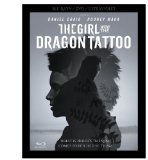| Reviews & Columns |
|
Reviews DVD TV on DVD Blu-ray 4K UHD International DVDs In Theaters Reviews by Studio Video Games Features Collector Series DVDs Easter Egg Database Interviews DVD Talk Radio Feature Articles Columns Anime Talk DVD Savant Horror DVDs The M.O.D. Squad Art House HD Talk Silent DVD
|
DVD Talk Forum |
|
|
| Resources |
|
DVD Price Search Customer Service #'s RCE Info Links |
|
Columns
|
|
|
Girl with the Dragon Tattoo, The
Dark deeds in the Scandanavian snow
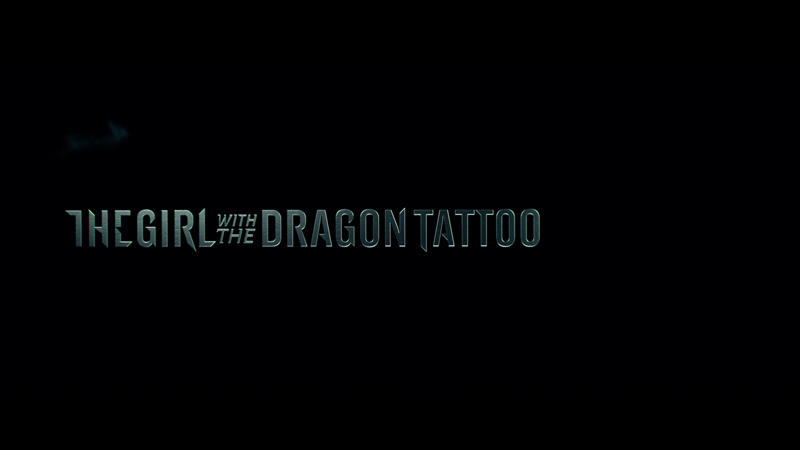
Reviewer's Bias*
Loves: David Fincher, serial killer stories, research
Likes: Good mysteries, journalism
Dislikes: Bleakness
Hates: Piercings, tattoos
The Movie
Stieg Larsson's popular "Millennium" trilogy of novels, starring journalist Mikael Blomkvist and researcher/goth-punk icon Lisbeth Salander, are a lot of things to a lot of people, including the root of much discussion as to whether they are just pulpy, pot-boiler page-turners or top-quality, envelope-pushing literature. They are also the source for a trio of well-regarded Swedish film adaptations, and now the first entry, The Girl with the Dragon Tattoo, has been made into a blockbuster American film by modern movie master David Fincher. Considering the man's track record for adaptations (and quasi-adaptations) which includes Fight Club, Zodiac and The Social Network, you have to give the book the benefit of the doubt.
Naturally, the story centers around the titular "Girl," the anti-social Lisbeth (Rooney Mara) a dark-haired, pierced and deeply troubled piece of work who's most comfortable around data, and least comfortable around other people. When she's hired to investigate Blomkvist (Daniel Craig), a reporter recently found guilty of libel for his accusations toward a rich industrialist, she finds herself intrigued by him, though she keeps her distance. It's only when he learns of her investigation, as he proceeds with his own on behalf of Henrik Vanger (Christopher Plummer), the head of Vanger Industries, that the two meet. Recognizing the value of her skills, Blomkvist recruits Lisbeth to work on the case, beginning an unlikely, yet fruitful partnership.
Beyond the relationship between Lisbeth and Blomkvist, the film's driving force is the mystery they are investigating, the disappearance of Henrik's niece 40 years earlier. Though the investigation sports all the hallmarks of classic detective work, it's not the most original whodunit, especially with the cliche elements of a rich, influential family rife with in-fighting and small-town distrust for outsiders. Then, once the truth is revealed, it's actually rather frustrating, for a number of reasons, but that's thankfully not a deal-breaker. There are far more interesting developments and characters that branch off the investigation, while the development of the main characters is the movie's main, yet subcutaneous purpose.
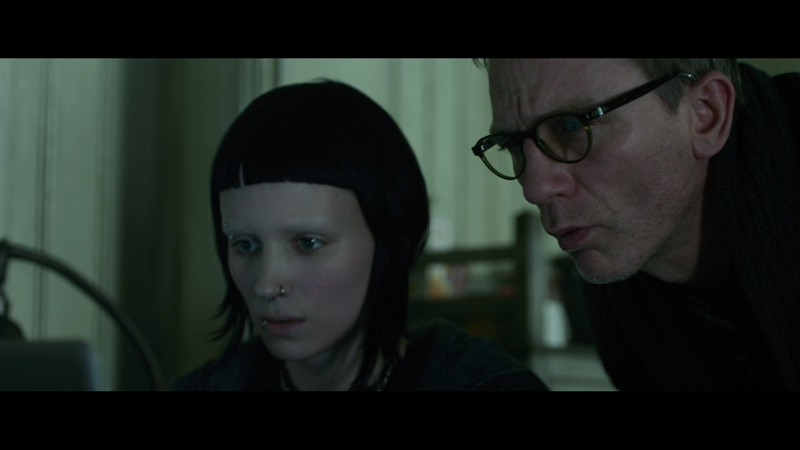
There had to be some temptation to bring together the two stars earlier in the film, but Fincher and company managed to wait a whole thirty minutes longer than the Swedish version, putting you almost halfway into a 158-minute film. It's an incredible display of patience for a big-budget studio film, and it pays off by developing both characters and their worlds fully before putting them on a head-to-head collision course. That said, some of what we experience with Lisbeth feels a touch exploitative. Could we understand her troubled mental state without seeing her suffer so dramatically? Very possibly. Blomkvist, on the other hand, could have used a bit of beefing up, as his character just never feels very worthy of the camera's attention, coasting a great deal on Craig's natural presence. It'd be hard for any character to stand out next to Lisbeth's visual power (not to mention the influence of Mara's ability), but Blomkvist is barely an entity at times, which makes it that much harder. If you put someone of lesser stature than Craig in the role, you'd risk him disappearing from the screen.
The level of detail developed throughout the film, a Fincher trademark, ends up being one of the film's biggest strengths, as this foreign world becomes very real through all the bits of information gleaned, which also enhances Blomkvist and Lisbeth's investigation. Detail assists with the way Fincher tells the story as well, which is frequently without words, delivering some of the most effective segments of the film. Though the mystery is the structure for the film, filled out by the relationship between Blomkvist and Lisbeth, the atmosphere and feel is nearly as important, and by showing rather than telling, everything is more visceral and entrancing. I'm a huge fan of research, and can do it for hours on end, but I get that it's not the most fascinating thing to watch. Fincher has managed to make it as exciting as hand-to-hand combat. Part of it is the use of sound, which is outstanding, from the littlest Foley elements to the striking voiceover of several clues to the score to audio cues you can't quite place, yet evoke strong emotions. The use of an Enya song at one point is as audacious as it is inspired, and though it risked pushing the film to a point of camp, it fit the moment and character, and made it truly memorable, a description that fits just about every sound you hear.
Of course, one of the big discussions about this movie is how it stacks up to the native Swedish adaptation, directed by Niels Arden Oplev and starring Noomi Rapace. That film set the visual tone for Lisbeth's world for most of the planet, making it a bit harder for Rooney and Fincher to make their own mark on the character. Though both films tell mostly the same story, with a few changes here and there, the American version does a better job of establishing a dark, foreboding atmosphere, thanks to Fincher's eye (aided by frequent collaborator DP Jeff Cronenweth) and a far healthier budget. Mara also manages to deliver a Lisbeth that feels more appropriate for the story, again aided, though this time by some alterations to the story which make her more of a loner and less stable in her ability to relate with others. There's nothing wrong with Rapace's performance, and her abuse feels a touch more harrowing, but Rooney just feels closer to what you'd expect from someone in Lisbeth's position.
Little changes also lean in Fincher's favor as well, as things like the level of information shared about the murders and the way the Vanger family is portrayed raise the stakes. In the Swedish adaptation, though it's obvious something wrong has happened, the film isn't dripping with the sense of dread felt in the American version. The big confrontation toward the end is also far more disturbing in this newer film, while the ending is vastly more satisfying (though it still suffers from the story's five-act structure, despite expert use of montage and audio to enhance the pacing.) Sure it might be considered blasphemous to rate the American version higher than the Swedish adaptation of the biggest Swedish book...ever, but come on. It's Fincher, and the fact that you don't have to read lets you really soak in the mood of the film.
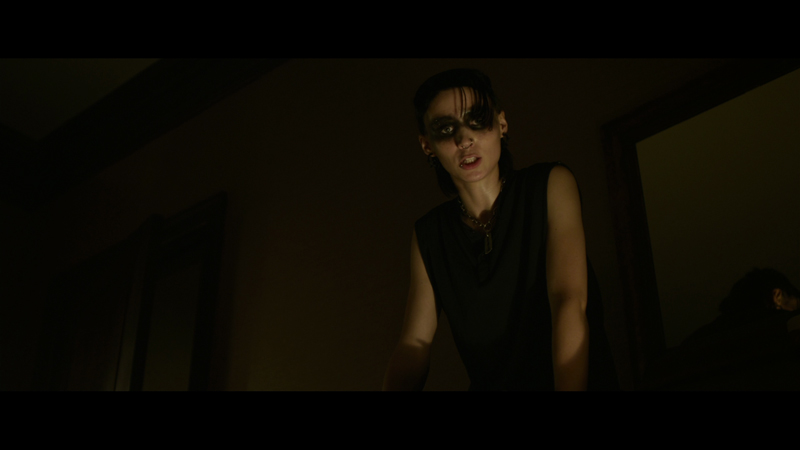
The Discs
This film arrives in a three-disc set housed in a two-tray digipack, which is wrapped in a classy metal-ink printed, matte-finish slipcase. The main disc features options to watch the film, select scenes, adjust the languages and check out the extras, while the second disc features thematic menus built into the design of the screens. Audio options include English and French 5.1 DTS-HD Master Audio tracks, an English 2.0 Dolby Digital track and an English DVS track, while subtitles are available in English, English SDH, French, Arabic, Hebrew, Hindi and Spanish.
Also included is a DVD of the film (with optional commentary) which is presented as a recordable disc, with the film's name scrawled across it. It's a neat touch for the set.
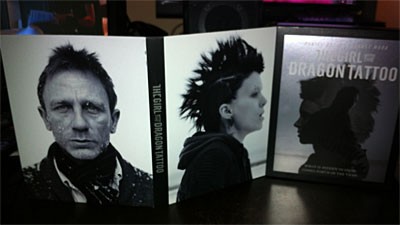 | 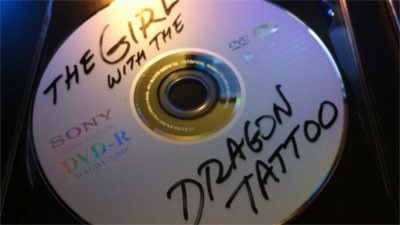 |
The Quality
The 1080p AVC-encoded transfer here is a gorgeous reproduction of a less-attractive vision, as the film tends to stick to dark, color-light environs, and the disc handles these challenges smoothly. From the opening titles, which are basically black on black images, you can see how clean an image this movie is offering and how well black levels are delivered, as there's no missing the haunting imagery being presented. Occasionally the film expands the palette to include some warm, brassy tones and well-lit springtime scenes, and these are handled just as well, and truly pop in contrast. The level of fine detail is quite high, when the image allows it to be (there's some stylistic distortion in spots) showing off more of Fincher's attention to detail. It's not a perfect presentation, but 99 out of every 100 viewers will see no issues with the image, as the flaws are minor at most, thanks to a near complete lack of digital distractions in the transfer.
Even without a high-end mix it would be hard for this film to not sound great, as the audio was crafted so well it is an integral part of the movie. Thankfully, that work gets a premium presentation via a DTS-HD Master Audio 5.1 track that impresses at every turn. There's so much at work aurally in this film, from the forefront sound effects to the score to atmospheric touches and soundtrack cuts. When Lisbeth delivers a rather sensitive kick, the sound was actually cringeworthy, while you'll jump when sounds suddenly burst into a scene. The soundstage is hugely immersive, with audio whipping around the viewer, matching the movie step-by-step. It's hard to think of the last movie that was so enhanced by the audio, the way this film is (though it was probably The Social Network.)
The Extras
The key extra is a feature-length audio commentary from Fincher, which maintains his traditional high standard, as he talks a great deal about the story and the production process, touching on some technical facets, but staying mostly on the "why" rather than the "how," like including an explanation of a somewhat controversial line Fincher himself added to the script. Considering he is speaking, by himself, for over two and a half hours, the short pauses he takes are excusable, as he's nearly non-stop the rest of the way, being as detail-oriented as he is known to be on-set.
SPOILER ALERT: Some of the extras mentioned below could reveal major elements of the film's plot. If you haven't seen the film, do not read if you do not want the story ruined for you.
The second Blu-Ray is home to the Vanger Archives, a deep compilation of behind-the-scenes materials, split into five categories: "Men Who Hate Women," "Characters," "On Location," "Post Production" and "Promotion." The whole thing is presented with a grainy look and feel that is reminiscent of Se7en, featuring newspapers, map drawers and file boxes. The first entry, "Men Who Hate Women" runs 6:40, and focuses on the source material, via interviews with all the main players, including Fincher, as they talk about the novel, its spot in Swedish and international culture and the challenges of adapting such a physically big book into one movie.
"Characters" is made up of three groups of extras, covering Lisbeth, Blomkvist and Martin. For Lisbeth, there are six parts, "Casting Salander" (15:42), "Different in Every Way" (5:32), "The Lool of Salander" (14:06), "Mara/Fincher" (4:09), "Irene Nesser" (6:25) and "Salander Test Footage" (2:53) There's hardly an element about the character and her creation that doesn't get explored in these 48 minutes, especially the way Mara got the part and the development of Lisbeth's visual make-up, with interviews and on-set footage telling the story. Some of the most interesting bits are those that show and explore the working relationship between Fincher and Mara, and the influence that costume designer Trish Summerville had on the character.
Blomkvist doesn't get nearly as in-depth a review, with four featurettes, "Casting Blomkvist" (6:44), "Daniel Craig on Film Acting" (3:31), "Dressing Blomkvist" (2:56) and "Investigation (Stills)". One can't help but feel this little group is really more about Craig than Blomkvist, as the gallery is barely about the character, one is named for the actor and all three of the videos ooze with Craig's good-guy charm. Whether they are about Blomkvist or not, they are entertaining.
Martin gets the spotlight in the last group here, with six segments of his own: "Stellan Skarsgard on Film Acting" (3:13), "Psychopathy" (6:11), "Bondage" (5:29), "Torture" (4:09) "Wrapped in Plastic" (4:37) and "Set Design (stills)." Honestly, of the bunch, only the first two are really about Martin, as the following three are about how scenes related to him were shot, though Skarsgard does share a bit about the effect of shooting with a Red camera on his acting.
"On Location" is broken into two sections, Sweden and Hollywood, which add up to over 98 minutes of featurettes. Sweden has five parts, with "Stockholm Syndrome" (17:54), "Stockholms Tunnelbana" (6:24), "F**k These People" (6:03), "The End" (11:58) and "Picture Wrap" (6:53), while Hollywood has seven: "Casting Armansky" (4:44), "Armansky Audition" (6:42), "Thinking Evil S**t" (5:09), "Rape/Revenge" (16:52), "Int. Blomkvist's Cottage" (5:42), "Int. Martin's House" (7:39) and "Int. Salander's Apt." (2:40). The "On Location" title is a bit of a misnomer, at least it created expectations that weren't fulfilled, as most of these belong here just because of where they were shot, not because the location is that important to the theme (especially the casting and audition footage with Goran Visinjic.) That said, this is a pile of fantastic insights into the production, including challenges and experiences on the set, looks at shooting techniques and a truly thoughtful examination of the film's rape scenes, with on-set footage and interviews. There's a great deal of raw footage from the set that's supplemented by interviews, which gives you a rarely-seen view of movie making.
With the movie shot, it's on to "Post-Production," a four-part section that starts with "In the Cutting Room." Fincher is known to shoot miles of footage when creating a film, so it makes sense to spend a good deal of time on the editing process. Here, there's nearly 15 minutes on how the film was cut, including thoughts on the advantages of working with high-resolution Red footage as an editor and a "live" look at Fincher talking out decisions with his editors, with before-and-after looks at the results. After getting things to look good, now they have to sound good, which is where "ADR" (6:37) comes in, as you get to see Fincher direct Mara and Skarsgard as they re-record dialogue in the studio. For all the craziness you hear about Fincher's directing style, from these moments, he seems pretty fun to work with.
"Main Titles" gives you the chance to really examine the unique CG title sequence created by Blur Studio, via a three-part splitscreen with the final product, a rough version and a wireframe concept stage, as well as on-the-fly views of all three in full-screen, with optional commentary by Blur's Tim Miller, who talks about how the titles were conceptualized with Fincher. Being the opening titles, it goes quick, but it's so gorgeous you'll want to watch it several times and catch all the details, especially once you're told what it represents. After that, it's on to a "Visual Effects Montage" (6:01), which breaks down how many of the film's more subtle visual effects were composited to create the film's look. Sometimes you'll wonder just why so much effort was put in, but then you'll also appreciate the artistry that went into the film.
The final group of footage is "Promotion," which kicks off with "Hard Copy," a fake "Inside Edition" type newsmagazine show made to promote the film online. Running about nine minutes long, it's a dead-on parody of those tabloid shows, focusing on the Vanger clan (complete with bits of leftover commercial bumpers.) The clip has optional commentary explaining the origin and techniques used from Fincher's home-video producer David Prior, who doesn't get nearly enough credit for his work on Fincher's DVDs, and who spearheaded this production. The dead giveaway though is I'm pretty sure that the investigator on the tape is the teacher from Victorious.
Several TV ads are included for archival purposes, along with four trailers (including the awesome teaser), but oddly the trailers here are numbered 3, 4 and 5. Where's 1 and 2? The final extra is a wordless look at the creation of the film's limited-edition metal poster, which is basically the most stylish How It's Made segment ever. When the set was announced, a commentary by Prior was mentioned for this, but unfortunately that's not available, leaving this section a bit short compared to the others.
On the plus side, with all of these featurettes, we get a ton of Fincher, who is one of the most compelling filmmakers working today. The chance to hear so many of this thoughts, not just about this film, but filmmaking in general, as well as the opportunity to watch him in action, is inspiring and entertaining for anyone with an appreciation for not just the art but the science of film.
Also included on the second disc are disc production credits (which are stepped through, screen by screen) and English subtitle options.
In addition to the bonus DVD copy of the film (which includes Fincher's commentary) there's also a code to download an UltraViolet copy of the film.
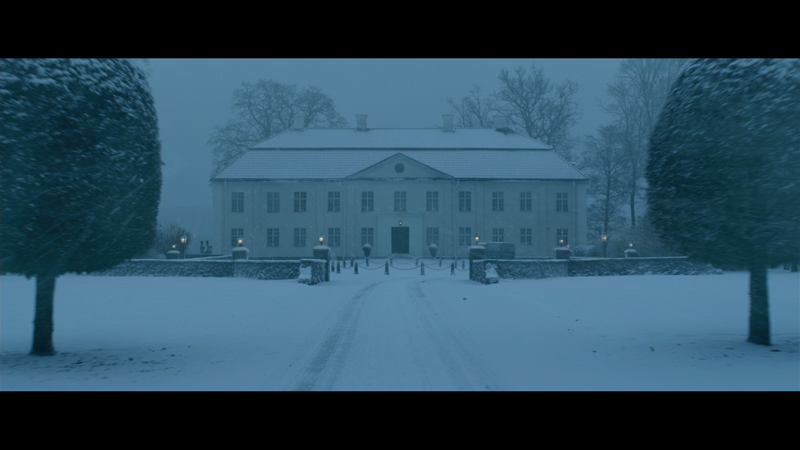
The Bottom Line
It's unlikely that there's another creative force working in Hollywood today that hits the consistent heights Fincher reaches with seeming ease, in both his films and the home video releases that accompany them. A stylish, moody, contemplative adaptation of a revered international bestseller set in a foreign country, this effort was as challenging as anything he's tackled in the past, yet is, outside of some disturbing scenes of violence, possibly his most accessible work to date. For those who take the icy plunge, this set offers an in-depth look inside the production, and gives fans a more complete understanding of the film, its characters and its story than you could ever get from sitting in a theater seat, while being nearly as well-made, thoughtful and entertaining as the movie itself, which is saying something.
Francis Rizzo III is a native Long Islander, where he works in academia. In his spare time, he enjoys watching hockey, writing and spending time with his wife, daughter and puppy.Follow him on Twitter
*The Reviewer's Bias section is an attempt to help readers use the review to its best effect. By knowing where the reviewer's biases lie on the film's subject matter, one can read the review with the right mindset.
|
| Popular Reviews |
| Sponsored Links |
|
|
| Sponsored Links |
|
|
| Release List | Reviews | Shop | Newsletter | Forum | DVD Giveaways | Blu-Ray | Advertise |
|
Copyright 2024 DVDTalk.com All Rights Reserved. Legal Info, Privacy Policy, Terms of Use,
Manage Preferences,
Your Privacy Choices | |||||||









